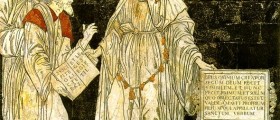> Home > >

011 Tarsia pavimentale della navata centrale - Ermete Trismegisto Siena
Artist: Giovanni di Stefano
Year: 1488
Current location: Cattedrale di Santa Maria Assunta
Original location: Cattedrale di Santa Maria Assunta
DESCRIPTIVE INFORMATION
The first scene in front of the main entrance, where there is also the inscription "castissimum virginis templus caste ingredi memento", depicts Hermes Mercury Trismegistus, Egyptian scholar who is remembered as the depositary of the entire ancient wisdom, and knowledge of the earthly symbol of the beginning . How do you explain the scroll at his feet was considered a contemporary of Moses: Hermis Mercurius Trismegistus contemporaneus moysi. It is represented as an Eastern sage shown in the act of offering two other men with his right hand a book, while his left hand is supported by a quote written on a tombstone supported by two winged sphinxes. The two men, who commit an act of deference, it may perhaps typings of the sages of the East and West. The table reads deus amnium creator secum Deum et fecit visibilem hunc fuit primum et solum quo oblectatus east et valde amavit proprium filium here appellatur verbum sanctum. This is an allusion to the creation, carried out by the "Verbum sanctum." On the pages of the book it is printed: suscipite or licteras et legis egiptii, a reference to Egypt as the site of ancient wisdom, alluded to probably the two sphinxes. The design of the work, dated 1488, is attributed to Giovanni di Stefano, based on analogies with the Cumaean Sibyl.
011 Tarsia pavimentale della navata centrale - Ermete Trismegisto




